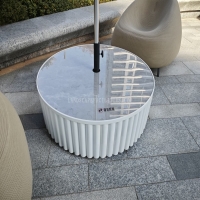Welcome to the website for landscape facilities products and knowledge.
How do landscape tables integrate with outdoor historical or heritage sites?
Landscape tables serve as a bridge between modern functionality and historical preservation in outdoor heritage sites. These thoughtfully designed elements harmonize with the site's aesthetic while providing practical seating solutions for visitors.
The integration process begins with meticulous material selection, often using locally sourced stone or reclaimed wood to match the site's architectural character. Designers carefully study the historical context to ensure proportions and styles align with the surrounding structures. Many heritage sites opt for minimalist designs that complement rather than compete with the historic environment.
Beyond aesthetics, landscape tables in these settings serve educational purposes. Some incorporate interpretive elements like engraved timelines or QR codes linking to historical information. This transforms simple furniture into interactive learning tools that deepen visitor engagement with the site's story.
Proper placement proves crucial in heritage settings. Tables are strategically positioned to protect fragile areas while creating natural gathering spots that follow historical pathways and sightlines. Many installations use permeable bases that minimize ground disturbance, an important consideration for archaeological sites.
Modern landscape tables also address accessibility needs in heritage locations without compromising historical integrity. Adjustable height options and wheelchair-friendly designs demonstrate how contemporary requirements can coexist with preservation goals.
The most successful integrations become nearly invisible enhancements - so naturally do they blend with their surroundings that visitors might assume they've always been part of the historic landscape. This seamless fusion represents the pinnacle of sensitive design in heritage environments.
Maintenance considerations differ significantly from standard outdoor furniture. Heritage site tables often require specialized cleaning methods and materials that won't damage surrounding historic fabric. Many sites implement protective measures like removable covers during off-seasons or special events.
These thoughtful integrations demonstrate how landscape architecture can respectfully enhance historical spaces, creating functional areas that honor the past while serving present-day needs. The result preserves the site's authenticity while improving visitor experience - a delicate balance achieved through careful design and cultural sensitivity.
Related search:

Recommendation
Round metal tube border design table with tempered glass or granite countertop on the top.